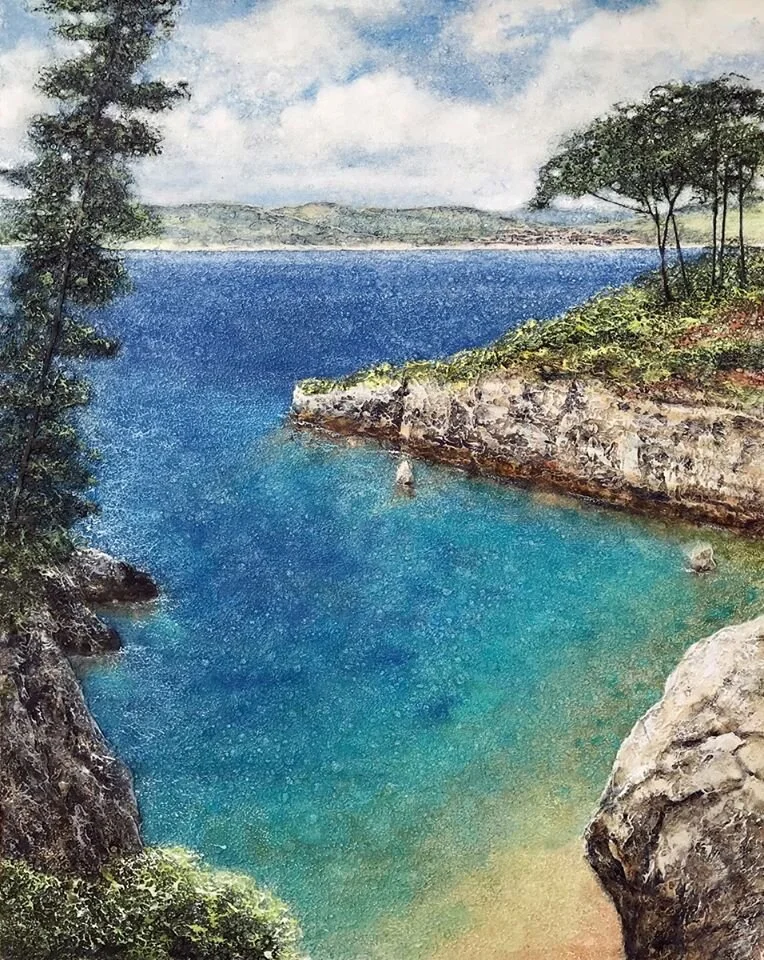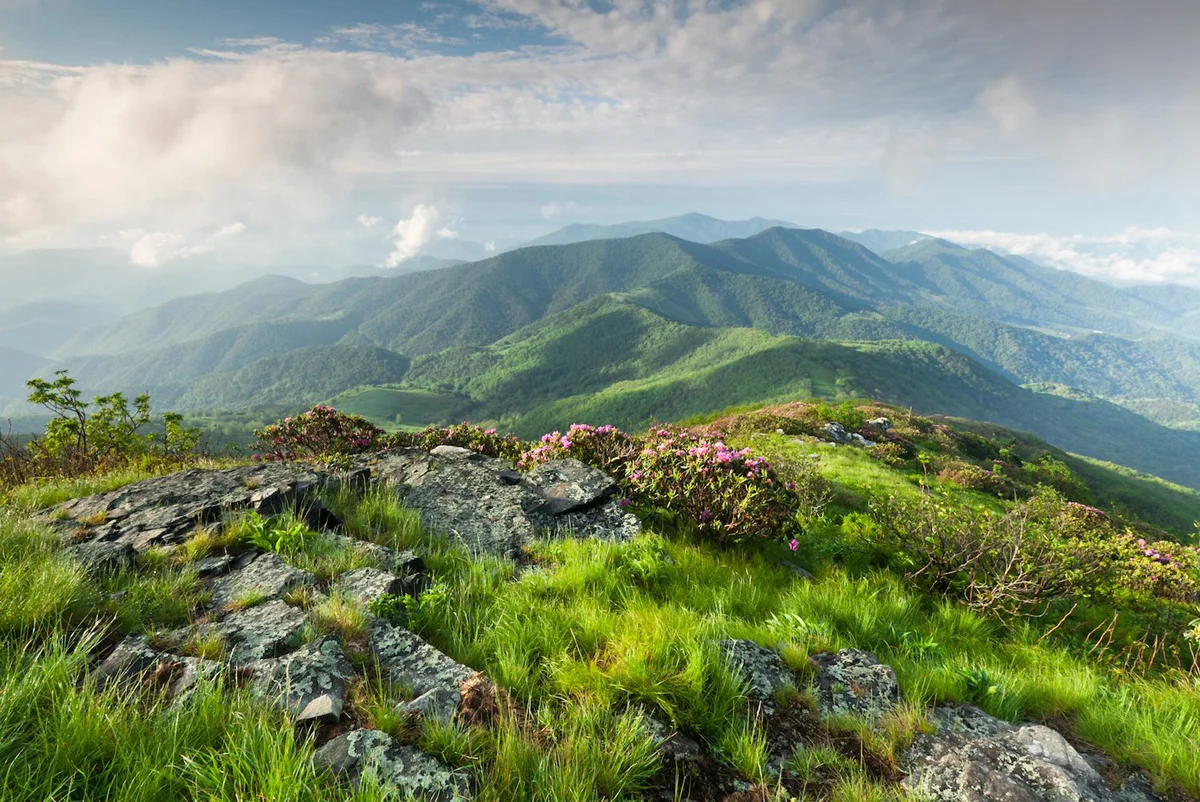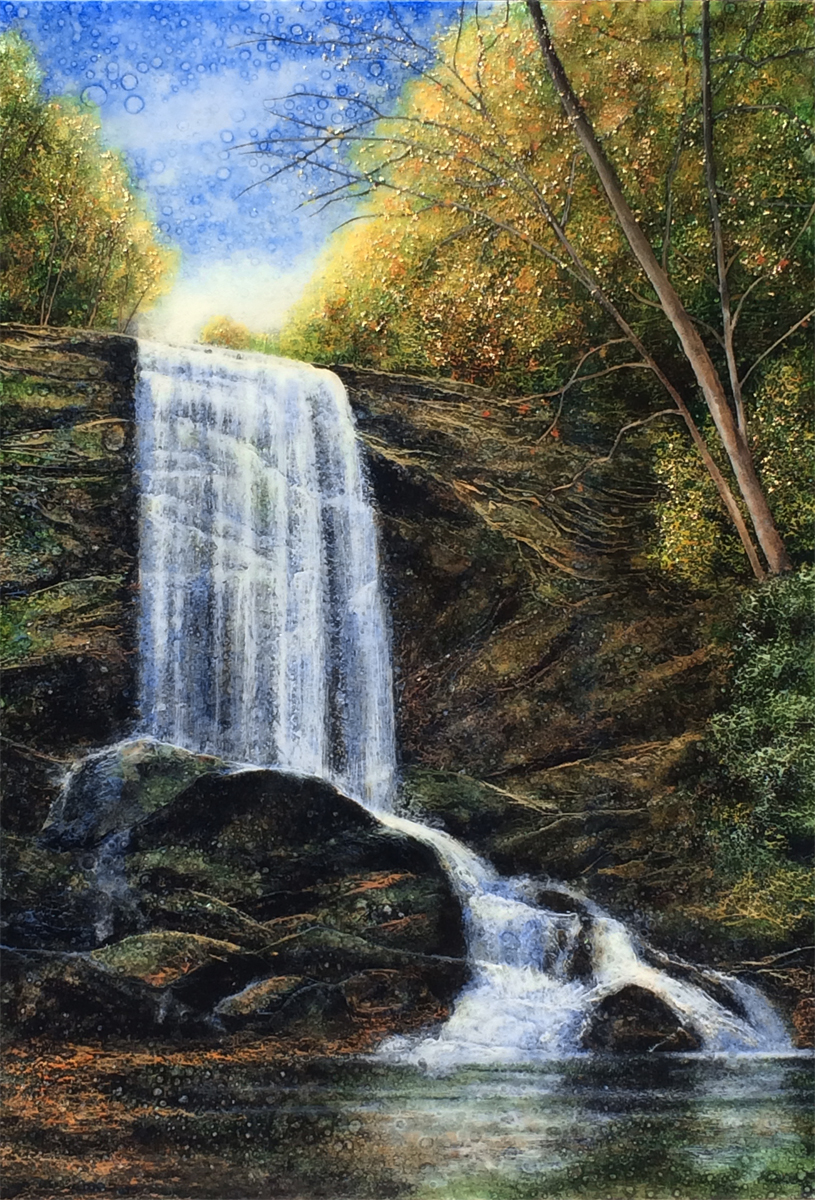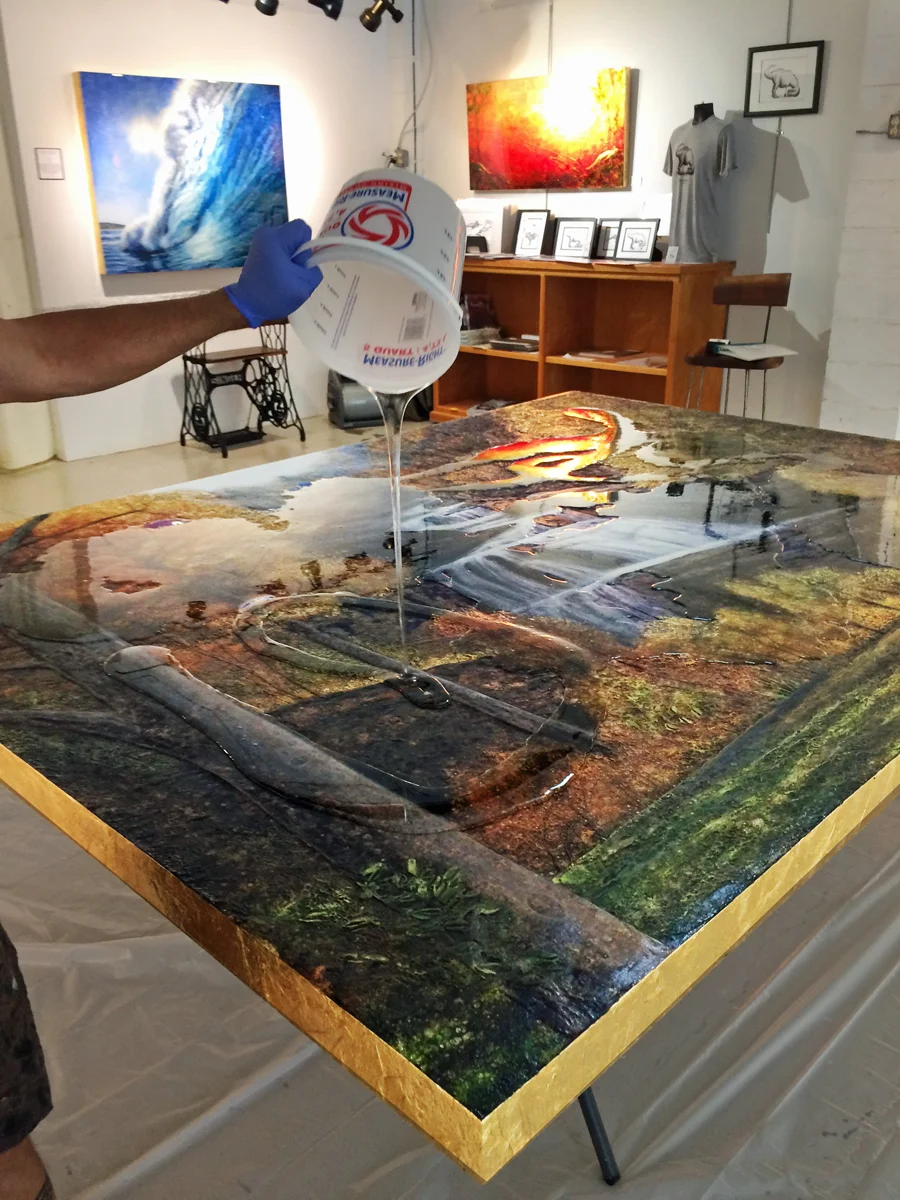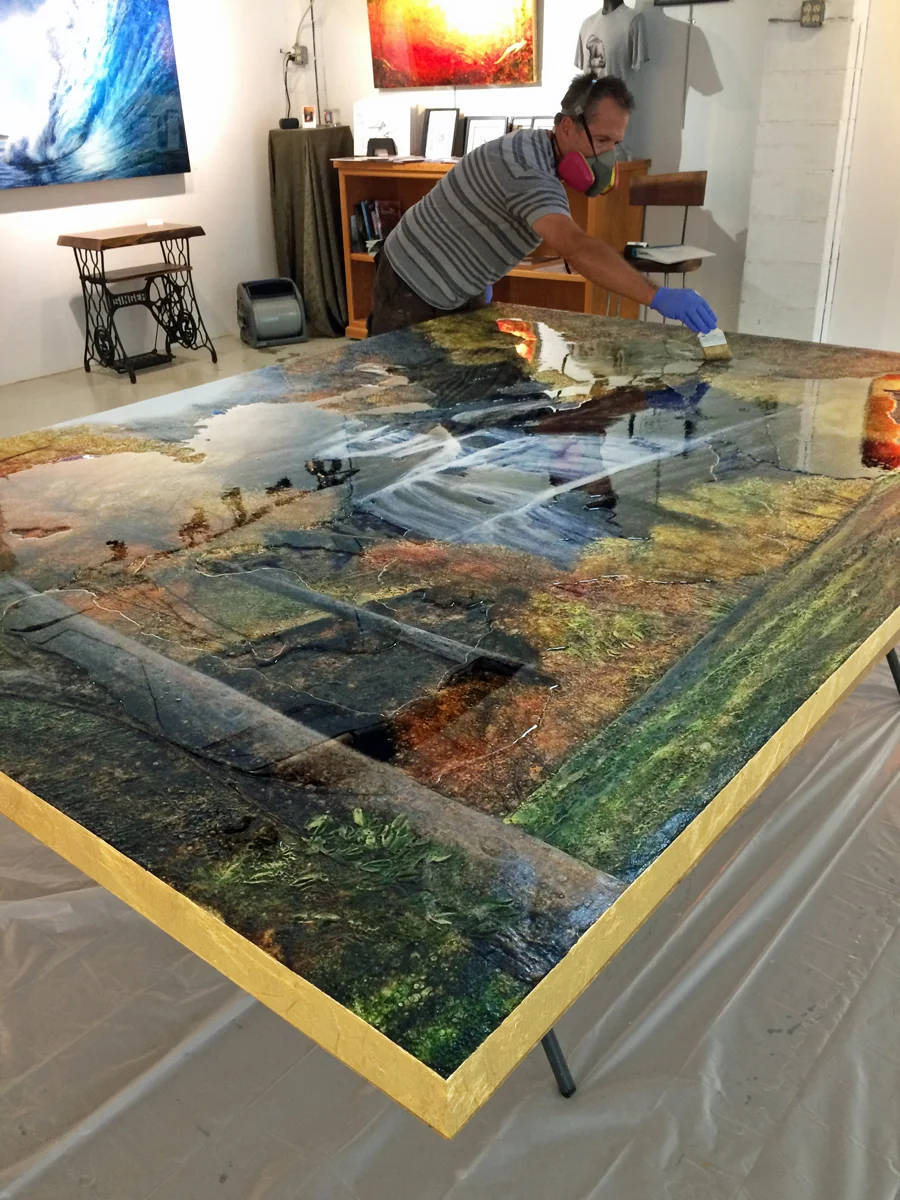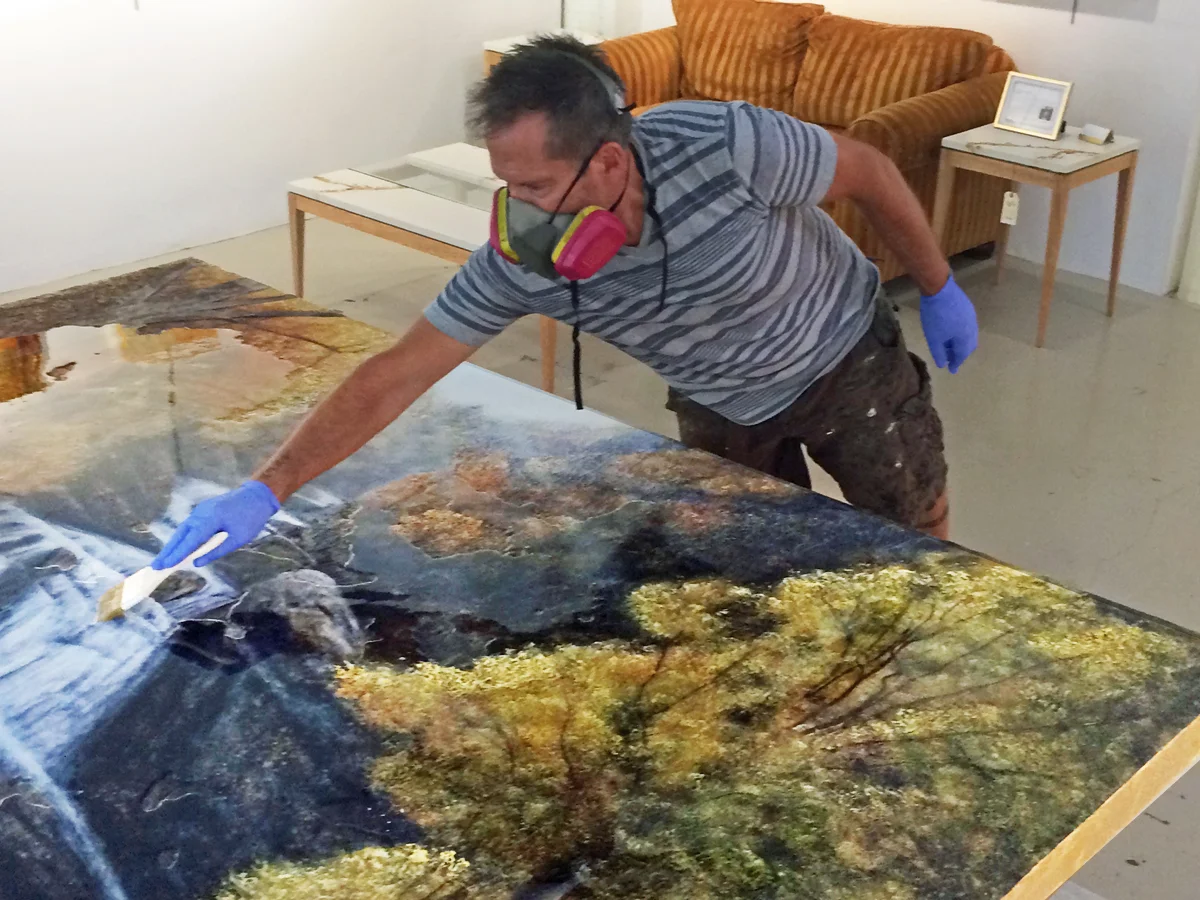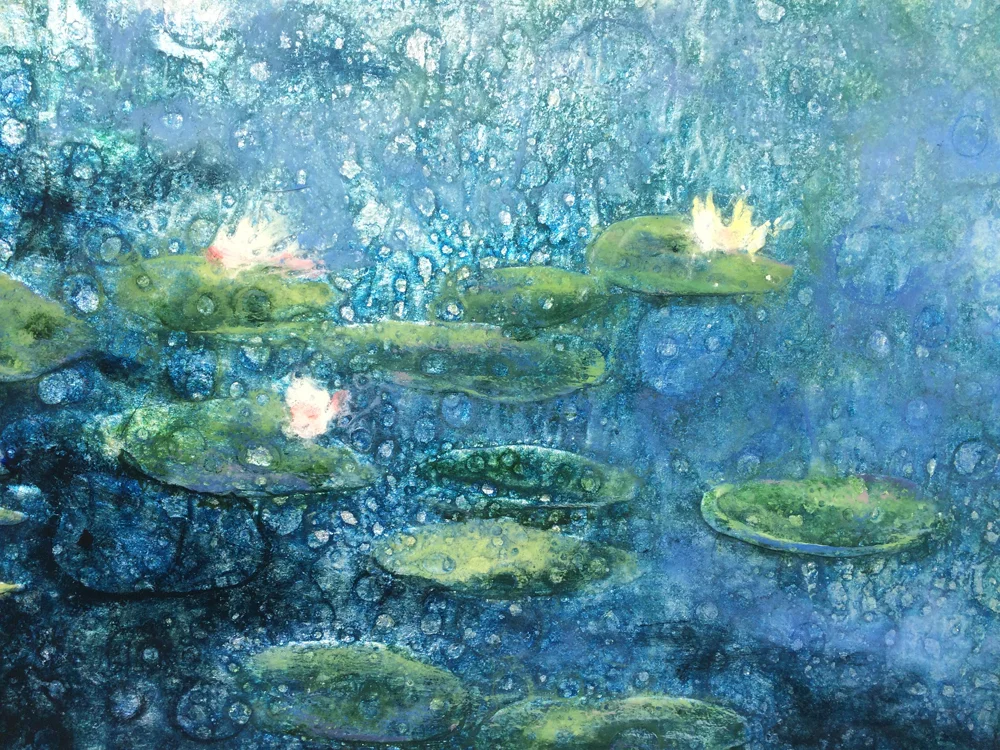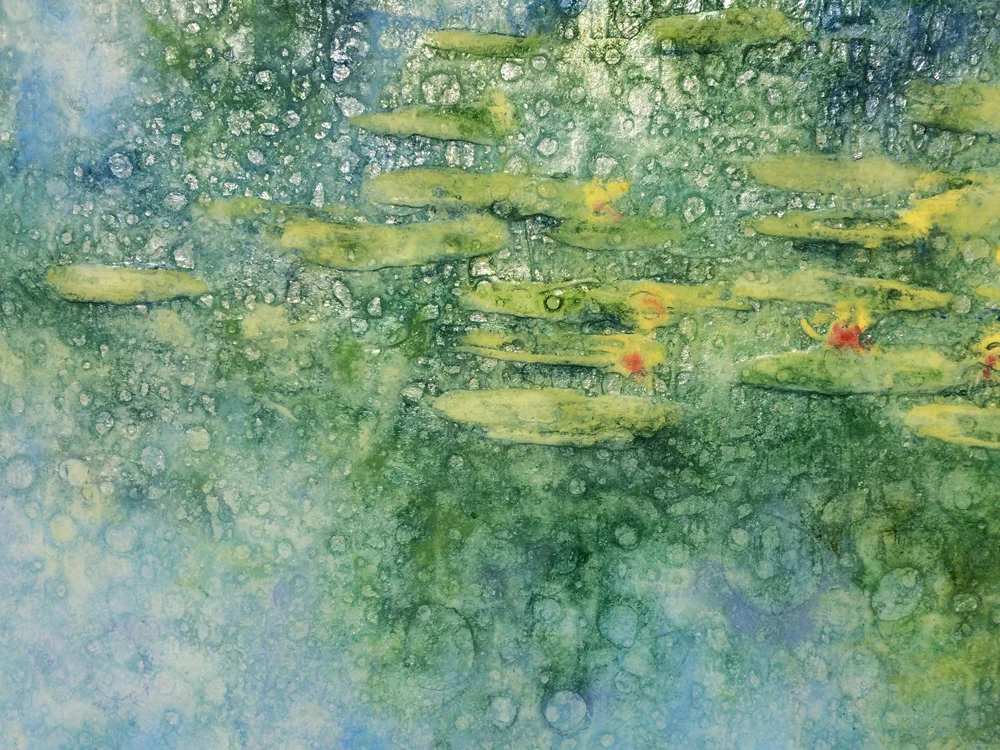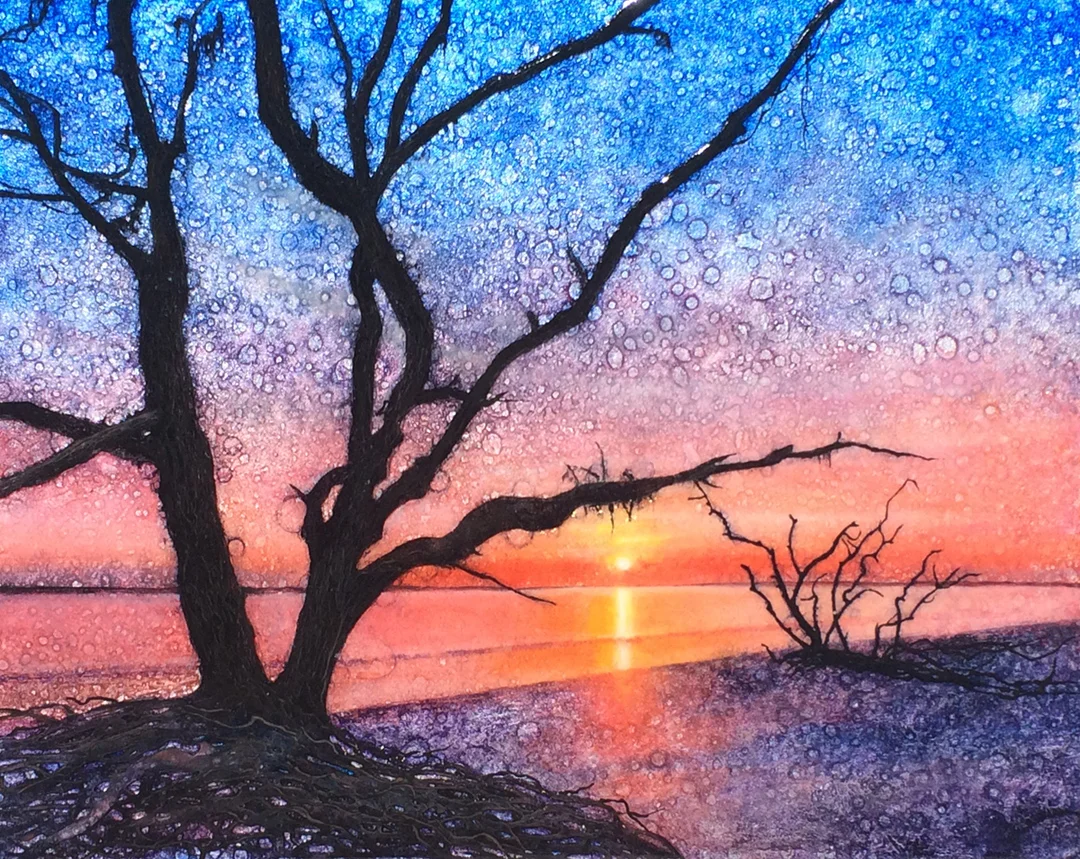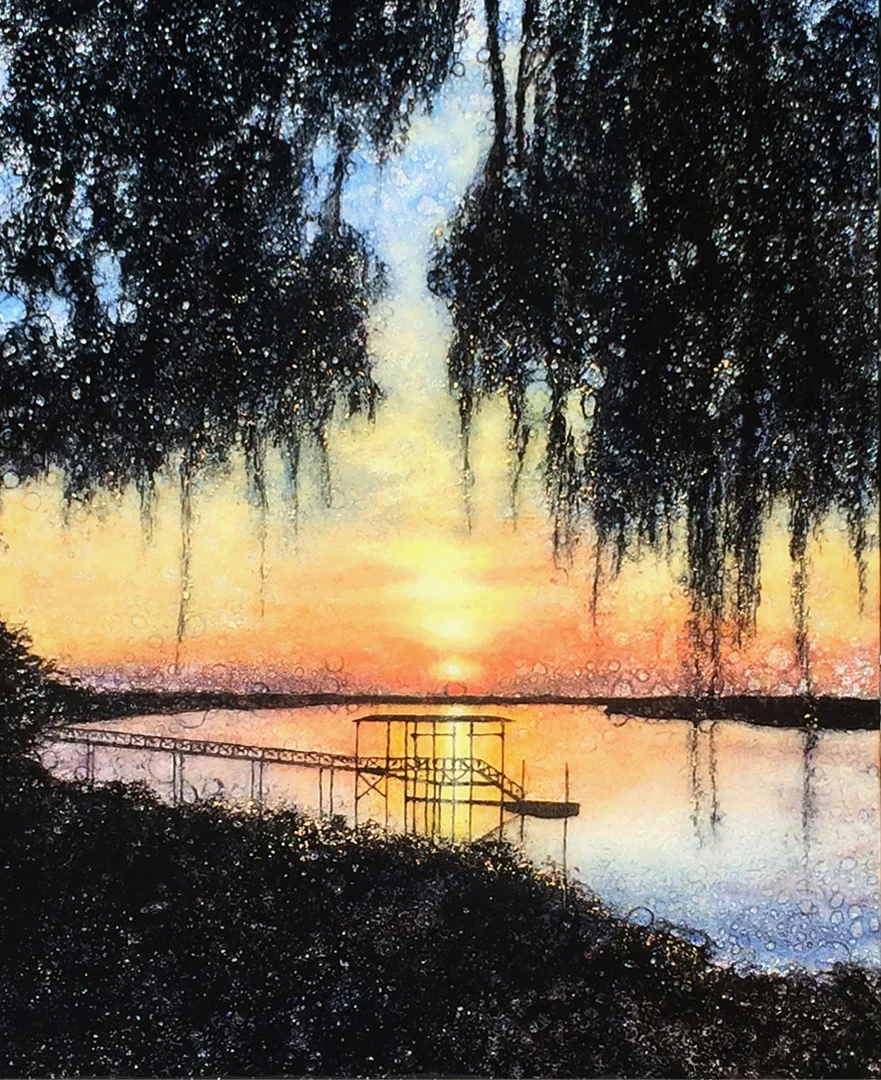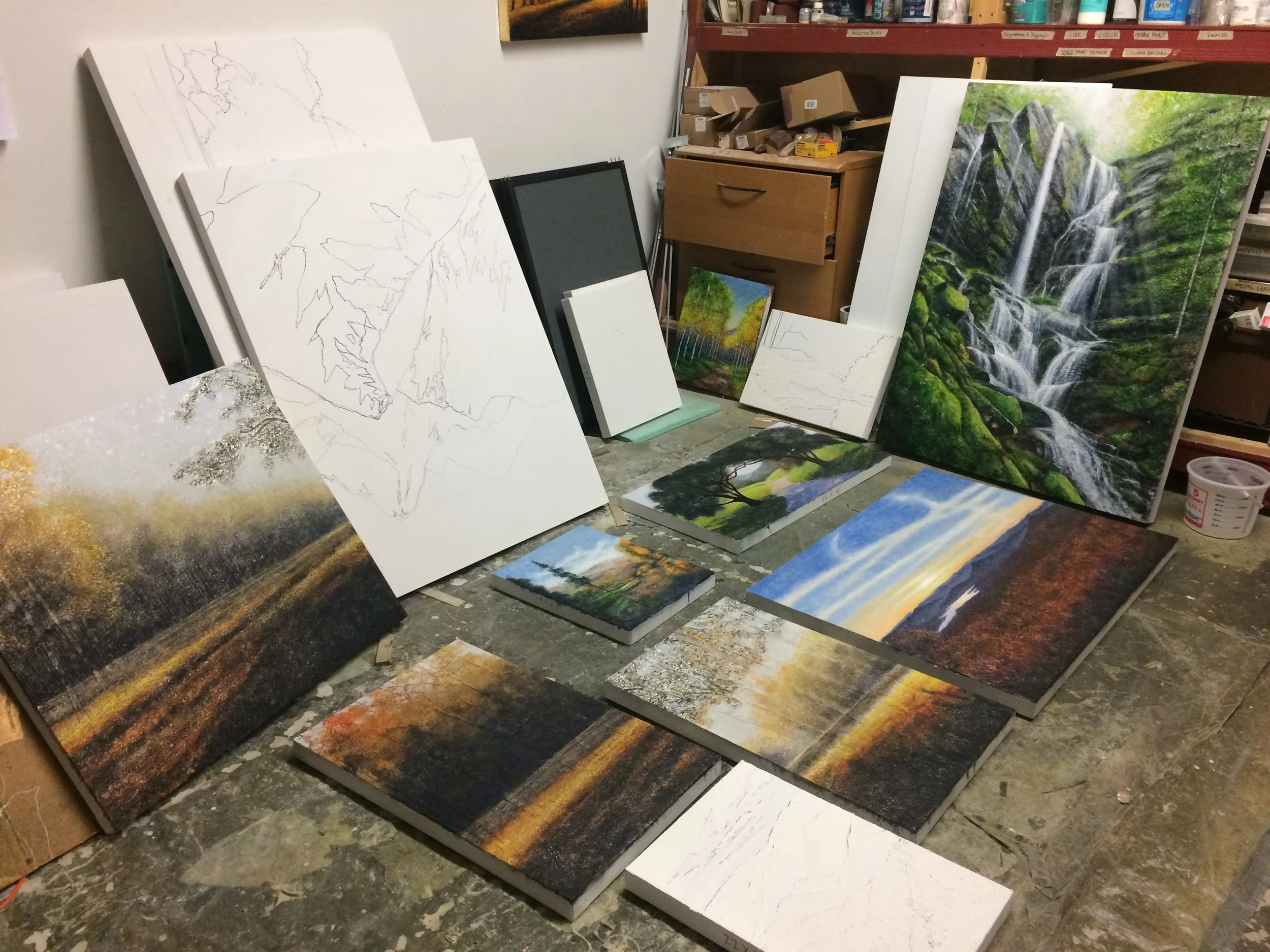
Art Blog
This blog is for posting photos of new artwork and for the expression of sometimes random thoughts of oil painter Stephen St. Claire.
Story Behind the Painting: Saint-Jean-Cap-Ferrat
“Saint-Jean-Cap-Ferrat”
I’ve had people ask about inspiration. “What’s the story behind this one?” I love that question. So for fun (and maybe mostly for my own entertainment, I thought I would recall some of these “stories behind the painting” here in this venue. So here is the first: “Saint-Jean-Cap-Ferrat”.
Last September, my wife Joy and I were gifted some time in the south of France by Joy's mom. We spent several days in Nice, and while we were there, my task was to find a really great beach. So I Googled "best beaches". Joy's only stipulation was that it would not be too crowded. That stipulation turned out pretty laughable, since this stretch of coastline is one of the most tourist-crowded coastlines in the world.
“…we spent time swimming in the most amazingly clear,
radiant blue water I've ever seen”.
So instead of a crowded beach day, we settled on a walking day. And what I randomly found on Google maps turned out to be one of the highlights of our whole visit to France. There is a peninsula just east of Nice called Saint-Jean-Cap-Ferrat and there is a footpath around nearly the whole peninsula. This little footpath seemed to be entirely unknown by tourists since we were about the only people on it, and here and there, there were tiny little inlets and beaches (completely empty beaches). This painting is based on the photo I took of the exact spot we stopped to have our lunch and where we spent time swimming in the most amazingly clear, radiant blue water I've ever seen.
I was resigned to share our beach day with 50,000 other visitors and instead, I shared a secluded little cove with my wife. What an awesome surprise.
SURVEY: GLOSSY OR SATIN
Even before I became a full-time oil painter in Asheville's River Arts District, I was developing a unique way to create a painting using dimension, both in the build-up of the composition and in the finish (which has mostly been using a thick, high-gloss, solar-resistant resin). In fact at this point, I think I'm probably known for that "shiny" resin finish. I like it a lot. It allows me to embed flecks of gold that are essentially "floating" above the surface of the actual painting.
That said, my largest commissions over the last couple of years have been with a satin varnish finish, which leaves all the texture visible (and touchable) and is not nearly as reflective as the high gloss resin. And I'm really liking the results of that finish as well.
Lately, I have more and more people asking about the satin finish and so I'm thinking I need to listen.
And so I'm asking for your brutally honest opinion:
Would you suggest I continue to produce paintings with a high gloss resin finish or would you honestly prefer a softer finish that leaves more of the texture showing and is much less reflective? You won't hurt my feelings either way and on the contrary, you'll really help me decide what direction I need to go now. (SEE PHOTOS BELOW FOR EXAMPLES OF BOTH)
HIGH GLOSS FINISH USING RESIN
SATIN FINISH USING SYNTHETIC (NON-YELLOWING) VARNISH
So, what do you think? One or the other, some of both? Mostly one, some of the other? I'm really open to listening. If you could leave your opinion below (so they're all consolidated in one place), that would really be appreciated! Thank you!
The Art of Dinner (with the Dallas Cowboys)
On Tuesday, June 5, Omni's Grove Park Inn asked me to be involved in an event called "The Art of Dinner". The way it works is that for a select group of people (the DALLAS COWBOYS actually), the chef from The Grove Park Inn is going to create a five course dinner which is their take gastronomic "interpretation" of my painting (below) entitled "Summer Walks Remembered", a painting inspired by teenage memories of one of the most amazing summers I had as a teenager.
Back in the day, my parents piled three kids and our dog (a Saint Bernard) into our station wagon and headed up the California coast from Los Angeles. We stopped and camped along the Oregon coast, visited family in the Seattle area and then headed north into Canada. Our eventual goal was Francois Lake, British Columbia to pick up my younger brother who was staying at a friends family cabin on the north shore of this incredible lake. This was true wilderness at the time. I remember one afternoon I went walking by myself up a pathway that led eventually to an upper wheat field that used to be used for livestock when the homestead was a working farm. The pathway was lined with aspen trees and wildflowers. It was one of those places you randomly visit and think "wait, stop. Stop and breathe. Remember this." And I did. The painting I'm bringing with me is based upon that very memory of a beautiful warm summer day in northern British Columbia.
I have no idea what a gourmet, edible version of my painting will be, but talk about creative! I love it. I'll be there with my painting, explain it, meet the chef and of course the players. What an incredible thing it is to live in Asheville!
Mountain Top Experiences
I'd heard of Roan Mountain for a long time. It's one of those "you have to hike this trial!" sort of places you hear about. I feel a bit like I've cheated myself because I've lived in Asheville, North Carolina for almost ten years and Joy and I have hiked countless trails, but we had not tackled Roan Mountain. And it's kind of odd that we waited so long, because as a landscape painter in the River Arts District, I paint local mountain scenes all the time. Every hike we take, I've got my camera ready and when I get back to my art studio, I start composing the next painting based on the best of the best photos. So hiking and photos go hand-in-hand for me, and they are both a very big part of what I end up painting. So, why did it take this long to discover Roan Mountain for myself? I have no excuses.
It turns out Roan Mountain isn't just a peak (i.e. it's not a singular mountain) but a whole range of bald peaks (no trees on the top) morphing into each other as you walk along Appalachian Trail heading north. So with our hiking poles, Camelbak's and lunch sacks in hand, we trekked from Carver's Gap north. The day was unusually clear and comfortable (I guess that's sort of unusual for that location) and we made good time -- even with all my stops to take photos. Finally, we reached the monument at the top of Grassy Ridge Bald and honestly, this afforded the most spectacular view I'd seen in Western North Carolina. Look one way, and you gaze about a hundred miles into North Carolina. Turn your head to the left, and you gaze about a hundred miles into Tennessee. Absolutely spectacular.
That hike gave me ideas for several paintings for the coming year. What kind of awesome job do I have anyway!? I just realized I can take my gas expenses as a tax write-off!
For more info on Roan Mountain, here's a great link.
Catawba Falls
I love Catawba Falls. It's a really beautiful waterfall at the end of a (sometimes steep) trail just down the mountain from us in Old Fort, North Carolina. The trail winds along the river and ends at a cliff and this really beautiful waterfall and pool (great for swimming in summer by the way).
Joy and I discovered Catawba Falls with the help of my daughter Camden. She had hiked here before and told us about the trail so...we had to discover it ourselves. This is one of countless waterfalls within an hour of our home here in Asheville. What an amazing thing it is to be a landscape painter in the River Arts District, so close to so much...uh...landscape! We try to get out and hike every day off (weather and house chores permitting).
This painting was commissioned by some very nice folks (Asheville locals) who came into my art studio and asked a question I LOVE to get asked: "Do you do commissions? We have a specific photo of a very special place to us". I love that. Of course, I was excited to talk to them about the project (about half of what I sell are commissions). I love commissions for many reasons. They are a pre-paid painting so uh, that's nice. But it's also a great way to not only get a nice piece of art (I'll keep painting it until it IS a nice piece of art) but it's also the opportunity to create something sentimental to the client. I've painted photos from honeymoons and vacations all over the world.
So...Catawba Falls is done and is to be picked up this week. If you want directions to the trail, just email me or swing by my Asheville studio. Cheers!
"Cullasaja Falls" Completion photo
Well here it is. Done. After just over 13 months, it's now hanging on my wall, and it's hard for me to get used to. It's actually shocking every time I pass by. "OMG! Okay yes, there you are!" It's like someone belting out a strain from a Wagnerian opera every time you walk by it (it's very hard to ignore).
I learned a whole lot from this project. I hadn't really don't much with the "waterfall theme" before, but now that I've gotten my feet wet so to speak (pardon the pun), I've got two other waterfall paintings nearly done (though much smaller in scale).
No other painting has been so challenging and really, no other has given me so much joy in it's creation.
"Under The Waterfall" by Thomas Hardy
'Whenever I plunge my arm, like this,
In a basin of water, I never miss
The sweet sharp sense of a fugitive day
Fetched back from its thickening shroud of gray.
Hence the only prime
And real love-rhyme
That I know by heart,
And that leaves no smart,
Is the purl of a little valley fall
About three spans wide and two spans tall
Over a table of solid rock,
And into a scoop of the self-same block;
The purl of a runlet that never ceases
In stir of kingdoms, in wars, in peaces;
With a hollow boiling voice it speaks
And has spoken since hills were turfless peaks.'
'And why gives this the only prime
Idea to you of a real love-rhyme?
And why does plunging your arm in a bowl
Full of spring water, bring throbs to your soul?'
'Well, under the fall, in a crease of the stone,
Though precisely where none ever has known,
Jammed darkly, nothing to show how prized,
And by now with its smoothness opalized,
Is a grinking glass:
For, down that pass
My lover and I
Walked under a sky
Of blue with a leaf-wove awning of green,
In the burn of August, to paint the scene,
And we placed our basket of fruit and wine
By the runlet's rim, where we sat to dine;
And when we had drunk from the glass together,
Arched by the oak-copse from the weather,
I held the vessel to rinse in the fall,
Where it slipped, and it sank, and was past recall,
Though we stooped and plumbed the little abyss
With long bared arms. There the glass still is.
And, as said, if I thrust my arm below
Cold water in a basin or bowl, a throe
From the past awakens a sense of that time,
And the glass we used, and the cascade's rhyme.
The basin seems the pool, and its edge
The hard smooth face of the brook-side ledge,
And the leafy pattern of china-ware
The hanging plants that were bathing there.
'By night, by day, when it shines or lours,
There lies intact that chalice of ours,
And its presence adds to the rhyme of love
Persistently sung by the fall above.
No lip has touched it since his and mine
In turns therefrom sipped lovers' wine.'
Finishing up "My Marathon"
Pouring the resin (FINALLY!)
I have been waiting for this resin pour for over a year now. This painting, my depiction of Cullasaja Falls, (pronounced Kull-uh-say-ja) was begun a year ago now, and at 6' x 8', it is the largest single panel painting I've ever done. It also is the most detailed piece I've worked on. Over this past year, I've had multiple visitors to my River Arts District art studio ask "Oh, when are you finishing THAT one!?" My answer has usually been "I have no idea. I'll just keep working on it until it says it's done".
The Journey
My first post about this piece was back on July 18th of last year. That post shows where this all started (a blank wood panel). A month later, my panel was prepped and I was beginning to apply my texture sketch. By November, my texture was applied and I was ready to seal the painting, preparing it for the application of the aluminum leaf. Eleven months later, I was in the "home stretch, starting to see the light at the end of the tunnel.
It's been really nice working on the painting this way. My original idea was that it would probably take six months to complete. Considering the fact that the rest of my oil paintings take about a month, I thought I was being generous with my six month time schedule. But six months came and went, uh, six months ago and I didn't care. The goal I had was to produce something that would (at least for this day in 2017) represent the very best I could possibly do, and to do that took a lot of time.
Well this painting is done now and last night, I poured the resin. And this time, rather than achieving a thick glassy smooth surface, I wanted to apply just one layer of resin. This left a lot of the texture quite visible. I spent weeks and weeks of texture application and didn't want to cover it all up, and with just one layer, the painting will sparkle.
Today (Tuesday) is my day off (THANK YOU RUTH VANN FOR WATCHING MY STUDIO ON TUESDAYS!) and I'm making myself wait until tomorrow morning to go in and inspect the piece. As long as I didn't have any gnats or flies dive-bombing into the resin while it was still curing, I'll be fine. And tomorrow is party time! By the end of the day, the largest painting I've ever painted will be hanging on my studio wall!
Giverny: My Homage to the Man
A few weeks ago, Joy and I were up in Pittsburgh visiting our oldest daughter Camden, her husband Joseph and our baby grandson Elisha (who is amazingly cute). Well, one of the days we were there, we went to the Carnegie Museum of Art(which was truly amazing). After snaking our way through corridors of modern art and the medieval art, we (finally) got to my personal favorite: the impressionists. And oh my gosh -- Actually being able to get up close and personal with a Van Gogh was almost a holy moment! And then...and then I saw it: water lilies. Claude Monet. My favorite of all my favorites. I was transfixed on this massive panel of water lilies. I could see the brush strokes and understand the mixing of paint. It was beyond incredible. And Camden said, "you know, when you get back to your studio, you should create a water lilies painting as an homage to your man here."
So I did. When I got back to my studio in Asheville, I began building water lilies on my canvas.
This piece is entitled "Giverny", named after the home of Claude Monet, who lived at Giverny, France for forty-three years, from 1883 to 1926. I think one of the big reasons I love Monet was that he was seemingly fascinated by the play of light and reflections on the water. He worked on many paintings executed on a floating studio (in Argenteuil or on the Dutch canals). He was obviously taken with the inverted reflections you find in these "liquid mirrors". In 1893, he purchased a piece of land situated at the end of a narrow arm of the River Epte (side note: this is the same river where the St.Claire's originally settled down after a life of being Vikings, but that's another story). And this piece of land became his home. The water lilies and painted and re-painted and re-painted nearly ad infinitum were all done here (in his back yard). I really want his back yard!
So this piece is my way of "taking my hat off to the master". It is my take (with my own technique and materials) on a well familiar theme. Thank you Claude.
Sunrise, Sunset...
Recently, some visitors to my Asheville art studio commissioned a couple of paintings from me, one of which featured a sunrise over Driftwood Beach on Jekyll Island (just off the coast of Georgia) and the other is sunset through Spanish moss hanging on oak trees in Florida. I think probably no matter where you are in the world, this time of day is the best, but the intensity of the colors and the length of the shadows are awesomely amplified when the sun is rising or setting over a body of water.
I have always loved twilight or daybreak. This time of day has be poetically referred to as the "time in between times". It is then the fairies (or fireflies), dipping and rising in their hypnotic evening dance.
Up to this point in my painting career, most of the oil paintings that I work on "daytime" themed paintings. Honestly, the technique I use to paint has proven to be a rather difficult technique to use in portraying dawn or dusk. But over this past year, I've learned that if I work much slower and apply layers of paint in much thinner layers, applying just one color family at a time, I have much more control over what's going on with the color and light in the piece. The results are something that I've been really, really excited about.
So...after finishing these two commissions, feeling rather confident in my new found abilities, I started four more sunset-themed paintings, this time featuring long distance views from the top of the Blue Ridge Mountains. Photos to come shortly!
Crossing the Bar
by Alfred, Lord Tennyson
Sunset and evening star,
And one clear call for me!
And may there be no moaning of the bar,
When I put out to sea,
But such a tide as moving seems asleep,
Too full for sound and foam,
When that which drew from out the boundless deep
Turns again home.
Twilight and evening bell,
And after that the dark!
And may there be no sadness of farewell,
When I embark;
For through from out our bourne of Time and Place
The flood may bear me far,
I hope to see my Pilot face to face
When I have crossed the bar.
"No Boundaries"
The Great Smoky Mountains
Becoming a national park was not easy for the Great Smokies. Joining the National Park System took a lot of money and the hard work of thousands of people. Establishing most of the older parks located in the western United States, such as Yellowstone, was fairly easy. Congress merely carved them out of lands already owned by the government—often places where no one wanted to live anyway. But getting park land in this area was a different story. The land that became Great Smoky Mountains National Park was owned by hundreds of small farmers and a handful of large timber and paper companies.
A New Idea
The idea to create a national park in these mountains started in the late 1890s. A few farsighted people began to talk about a public land preserve in the cool, healthful air of the southern Appalachians. A bill even entered the North Carolina Legislature to this effect, but failed. By the early 20th century, many more people in the North and South were pressuring Washington for some kind of public preserve.
Efforts to create a national park became successful in the mid-1920s, with most of the hard-working supporters based in Knoxville, Tennessee and Asheville, North Carolina. Surprisingly, motorists had the biggest role in the push for a national park. The newly formed auto clubs, mostly branches of the AAA, were interested in good roads through beautiful scenery on which they could drive their shiny new cars.
In May, 1926, a bill was signed by President Calvin Coolidge that provided for the establishment of Great Smoky Mountains National Park and Shenandoah National Park. This allowed the Department of the Interior to assume responsibility for administration and protection of a park in the Smokies as soon as 150,000 acres of land had been purchased.
Since the government was not allowed to buy land for national park use, the former political boosters became fund raisers. In the late 1920s, the Legislatures of Tennessee and North Carolina appropriated $2 million each for land purchases. Additional money was raised by individuals, private groups, and even school children who pledged their pennies. By 1928, a total of $5 million had been raised. The Laura Spelman Rockefeller Memorial Fund matched what had been raised and donated $5 million, assuring the purchase of the remaining land.
But buying the land was difficult, even with the money in hand. There were thousands of small farms, large tracts, and other miscellaneous parcels that had to be surveyed and appraised. The timber and paper companies had valuable equipment and standing inventory which required compensation. Worse, in some ways, were the emotional losses to people who had to walk away from their homes. Lifetime leases allowed some people to stay temporarily, particularly if they were too old or too sick to move. Others could be granted leases on a short-term basis. However, they could not cut timber, hunt and trap at will, or otherwise live as they always had.
The facts about this place (to me anyway) are interesting, but the real interest is the nitty-gritty history of this place. People lived out their lives here. They composed their music here, wrote their stories here and crafted their poems here. And walking the trails, you can still make out the presence of the past if you listen...
There’s an old weather bettion house
That stands near a wood
With an orchard near by it
For almost one hundred years it has stood
It was my home in infency
It sheltered me in youth
When I tell you I love it
I tell you the truth
For years it has sheltered
By day and night
From the summer’s sun heat
And the cold winter blight
But now the park commisioner
Comes all dressed up so gay
Saying this old house of yours
We must now take away
They coax they wheedle
They fret they bark
Saying we have to have this place
For a National Park
For us poor mountain people
They don’t have a care
But must a home for
The wolf the lion and the bear
But many of us have a tltle
That is sure and will hold
To the City of Peace
Where the streets are pure gold
There no lion in its fury
Those pathes ever trod
It is the home of the soul
In the presence of God
When we reach the portles
of glory so fair
The Wolf cannot enter
Neither the lion or bear
And no park Commissioner
Will ever dar
To desturbe or molest
Or take our home from us there
-By Louisa Walker
Blog Archive
-
2025
- Dec 14, 2025 Seeing Meaning: How Medieval Art Spoke Without Words Dec 14, 2025
- Nov 19, 2025 The Matterhorn and the Magic of Transformation Nov 19, 2025
- Nov 13, 2025 Commissions vs Completed Pieces…Which is Right for You? Nov 13, 2025
- Oct 28, 2025 What can I learn from Makoto Fujimura in 2025? Oct 28, 2025
- Oct 12, 2025 What can I learn from Pablo Picasso in 2025? Oct 12, 2025
- Oct 10, 2025 What can I learn from Raphael in 2025? Oct 10, 2025
- Oct 8, 2025 What can I learn from Georgia O’Keefe in 2025? Oct 8, 2025
- Sep 28, 2025 What can I learn from Caravaggio in 2025? Sep 28, 2025
- Jul 25, 2025 What can I learn from Thomas Gainsborough in 2025? Jul 25, 2025
- Jul 20, 2025 What can I learn from Leonardo da Vinci in 2025? Jul 20, 2025
- Jul 15, 2025 What can I learn from Michelangelo in 2025? Jul 15, 2025
- Jul 2, 2025 What can I learn from Van Gogh in 2025? Jul 2, 2025
- Jun 25, 2025 What can I learn from Renoir in 2025? Jun 25, 2025
- Jun 23, 2025 What can I learn from Claude Monet in 2025? Jun 23, 2025
- Jun 21, 2025 Using Complimentary Colors for Shading Jun 21, 2025
- Jun 17, 2025 How and When to use Complimentary Colors Jun 17, 2025
- May 30, 2025 Perspective in Art 101: How to Make Your Drawings Pop Off the Page May 30, 2025
- May 26, 2025 How to Really Understand Medieval Art May 26, 2025
- May 22, 2025 Staying Creative May 22, 2025
- May 10, 2025 AT Experience May 10, 2025
- May 3, 2025 Go Take a Walk! May 3, 2025
- Apr 25, 2025 Periods of Art: Mannerism Apr 25, 2025
- Apr 17, 2025 Finding Meaning in the Abstract: Pointers for Understanding Modern Art Apr 17, 2025
- Apr 16, 2025 The Quiet Labor Apr 16, 2025
- Apr 12, 2025 To Art: a Poem Apr 12, 2025
- Apr 5, 2025 The Enchantment of Art Nouveau Apr 5, 2025
- Mar 23, 2025 "What was it like going to art school?" Mar 23, 2025
- Mar 18, 2025 Why I Love the Rococo Period Mar 18, 2025
- Mar 4, 2025 Expressing Joy Through Art Mar 4, 2025
- Feb 28, 2025 The Connection Between Art and Frustration Feb 28, 2025
- Feb 23, 2025 Neoclassicism: Bringing Ancient Style Back to Life Feb 23, 2025
- Feb 18, 2025 On my walk Feb 18, 2025
- Feb 12, 2025 Art at the Very Beginning Feb 12, 2025
- Feb 10, 2025 Monet and Renoir: A Personal Reflection on Their Differences Feb 10, 2025
- Feb 6, 2025 The Fount of Creation: A poem Feb 6, 2025
- Feb 1, 2025 The Connection Between Art and Grief Feb 1, 2025
- Jan 29, 2025 A Journey Through Medieval Art: Stories from the Middle Ages Jan 29, 2025
- Jan 26, 2025 The Story of Art: The Romantic Period Jan 26, 2025
- Jan 16, 2025 The Relationship Between Music and Painting Jan 16, 2025
- Jan 12, 2025 Periods of Art: Baroque Jan 12, 2025
- Jan 11, 2025 Marketing your Artwork Jan 11, 2025
- Jan 7, 2025 Exploring the Golden Ratio in Art Jan 7, 2025
- Jan 3, 2025 Artistic Enlightenment: Lessons from Italy Jan 3, 2025
-
2024
- Dec 29, 2024 Why Travel is Crucial for Unleashing Creativity Dec 29, 2024
- Dec 22, 2024 Steps to Becoming a Full-Time Professional Artist Dec 22, 2024
- Dec 10, 2024 How to Determine Subject Matter for Your Next Painting Dec 10, 2024
- Dec 3, 2024 My Favorite Artist Dec 3, 2024
- Dec 1, 2024 Creativity and Exploration Dec 1, 2024
- Nov 13, 2024 Impressionistic Heroes of Mine Nov 13, 2024
- Nov 10, 2024 "So how do you DO this?" Nov 10, 2024
- Nov 3, 2024 Discovering the Bond Between Nature and Art Nov 3, 2024
- Nov 1, 2024 How Art Can Help Us Cope with Stress Nov 1, 2024
- Oct 27, 2024 How to Select the Perfect Art for Your Home Oct 27, 2024
- Oct 24, 2024 What to Do When You Feel Like Giving Up as an Artist Oct 24, 2024
- Oct 14, 2024 Book Review: The Artist’s Way Oct 14, 2024
- Oct 11, 2024 How to find Inspiration for your art Oct 11, 2024
- Sep 24, 2024 Crafting the Perfect Title for Your Artwork Sep 24, 2024
- Sep 14, 2024 The Worst Advice I’ve Ever Received as an Artist Sep 14, 2024
- Sep 8, 2024 Overcoming Artist’s Block: Practical Tips Sep 8, 2024
- Aug 30, 2024 Exploring Lessons from Vincent van Gogh Aug 30, 2024
- Aug 29, 2024 Why Purchase Original Artwork? Aug 29, 2024
- Aug 25, 2024 How do you determine the best size artwork to purchase? Aug 25, 2024
- Aug 15, 2024 "So, what's this painting worth?" Aug 15, 2024
- Aug 9, 2024 What color art would go best in my home? Aug 9, 2024
- Aug 4, 2024 How to deal with criticism as an artist Aug 4, 2024
- Mar 27, 2024 Question 12: "What do you do when you have a mental block?" Mar 27, 2024
- Mar 27, 2024 New Goals + Winter Months = "Outside the Box" Creativity Mar 27, 2024
- Jan 8, 2024 Question 11: Where do you get inspiration for your work? Jan 8, 2024
-
2023
- Sep 11, 2023 Question 10: "Do you have your work in galleries?" Sep 11, 2023
- Aug 27, 2023 Question 9: "How do you manage the business side of your art business?" Aug 27, 2023
- Aug 20, 2023 Question 8: "Do you advertise?" Aug 20, 2023
- Aug 13, 2023 Question 7: "How do you price your work?" Aug 13, 2023
- Jul 30, 2023 Question 6: "What are the positive points and negative points about having an 'open studio'?" Jul 30, 2023
- Jul 19, 2023 Question 5: "Would you mind critiquing my work at some point?" Jul 19, 2023
- Jul 1, 2023 Question 4: "Would you recommend art school, and if so, how would you find the right one?" Jul 1, 2023
- Jun 24, 2023 Question 3: "Did you go to art school? If so, where?" Jun 24, 2023
- Jun 16, 2023 Question 2: "How long have you been selling your work professionally?" Jun 16, 2023
- Jun 10, 2023 Question 1..."How long have you been an artist?" Jun 10, 2023
- Jun 4, 2023 So, you're thinking about art as a career? Jun 4, 2023
- Mar 3, 2023 "What inspires you as an artist?" Mar 3, 2023
- Feb 15, 2023 Should I buy a completed painting OR commission a painting? Feb 15, 2023
- Jan 23, 2023 "How do you Price Your Work?" Jan 23, 2023
-
2022
- Dec 1, 2022 An Artist in Italy (Part 3) Dec 1, 2022
- Nov 16, 2022 An Artist in Italy (Part 2) Nov 16, 2022
- Nov 8, 2022 An Artist in Italy (Part 1) Nov 8, 2022
- Oct 10, 2022 When Remodeling a Home... Oct 10, 2022
- Aug 22, 2022 How to Handle Failure Aug 22, 2022
- Jun 3, 2022 "What is it like being an artist these days?" Jun 3, 2022
- May 21, 2022 "Are All Artists Introverts?" May 21, 2022
- May 9, 2022 What Makes a Painting a Good Piece of Art? May 9, 2022
- Apr 1, 2022 The Story Behind…"Gentle Showers on a Summer Afternoon" Apr 1, 2022
- Mar 19, 2022 The Story Behind..."Blue Ridge Summer Afternoon" Mar 19, 2022
- Feb 18, 2022 Your Opinion Please... Feb 18, 2022
- Jan 22, 2022 What's in a Compliment? Jan 22, 2022
-
2021
- Dec 25, 2021 My Christmas Present to Joy Dec 25, 2021
- Dec 12, 2021 Deep in the Heart Dec 12, 2021
- Nov 29, 2021 "How do you know you're done with a painting?" Nov 29, 2021
- Nov 1, 2021 Does it Matter What Other People Think of My Art? Nov 1, 2021
- Oct 12, 2021 Creatively Inhaling... Oct 12, 2021
- Aug 31, 2021 More Fun than I Know What to do With Aug 31, 2021
- Aug 13, 2021 “Are You Self Taught?” Aug 13, 2021
- Jul 21, 2021 New Art Gallery on the West Coast Jul 21, 2021
- Jun 23, 2021 "Art from the Heart" vs "Commissioned Art" Jun 23, 2021
- May 28, 2021 More Questions and Answers May 28, 2021
- May 17, 2021 What does Diversity have to do with honest artwork? May 17, 2021
- May 4, 2021 More Questions and Answers May 4, 2021
- Apr 30, 2021 Questions and Answers Apr 30, 2021
- Apr 16, 2021 And the Next Blog Post is... Apr 16, 2021
- Mar 10, 2021 How do you create when you don't feel like creating? Mar 10, 2021
- Feb 11, 2021 "Mullaghmore": The Story Behind the Painting Feb 11, 2021
- Jan 28, 2021 A Look Back to "The Dark Year" Jan 28, 2021
- Jan 17, 2021 Studio Expansion...Hello Northeast! Jan 17, 2021
- Jan 7, 2021 How to Create the Perfect Painting Jan 7, 2021
-
2020
- Dec 1, 2020 A personal answer to a personal question... Dec 1, 2020
- Nov 4, 2020 Using Art to Express my Politics Nov 4, 2020
- Oct 16, 2020 Sometimes, just "having fun" is a good enough reason Oct 16, 2020
- Oct 4, 2020 The Best Painting Delivery Ever... Oct 4, 2020
- Sep 7, 2020 How a Dinky Little Virus Changed my Art Business Sep 7, 2020
- Aug 9, 2020 Adaptation: Survival of the Most Flexible Aug 9, 2020
- Aug 3, 2020 Story Behind the Painting: "Sundown over the Blue Ridge" Aug 3, 2020
- Jul 18, 2020 Cure for Covid blues Jul 18, 2020
- Jul 5, 2020 Where Does it Take You? Jul 5, 2020
- Jun 3, 2020 Story Behind the Painting: Autumn Day on the French Broad River Jun 3, 2020
- May 24, 2020 Story Behind the Painting: Saint-Jean-Cap-Ferrat May 24, 2020
- Apr 30, 2020 Q&A: SESSION TWO Apr 30, 2020
- Apr 22, 2020 Q&A: SESSION ONE Apr 22, 2020
- Apr 8, 2020 What I'll Miss When This Pandemic is Over... Apr 8, 2020
- Mar 20, 2020 Entertaining Angels Unawares Mar 20, 2020
- Mar 8, 2020 In Celebration of Art Mar 8, 2020
- Feb 27, 2020 "The Bridge" Feb 27, 2020
- Feb 8, 2020 The Most Interesting Question of the Year (but it's only February so...) Feb 8, 2020
- Jan 29, 2020 "Can I Watch You?" Jan 29, 2020
- Jan 14, 2020 From Point A to Point Z Jan 14, 2020
- Jan 5, 2020 An Impractical Idea Jan 5, 2020
-
2019
- Dec 17, 2019 My Beautiful Baby on Display Dec 17, 2019
- Dec 3, 2019 Regarding the Selection of an Artistic Theme Dec 3, 2019
- Nov 20, 2019 "What's Your Best Price on This Piece?" Nov 20, 2019
- Nov 13, 2019 A Really Unique Commission Project Nov 13, 2019
- Nov 6, 2019 Fun with Art Scammers Nov 6, 2019
- Nov 3, 2019 "How did you know you wanted to be an artist?" Nov 3, 2019
- Oct 30, 2019 How do you know when a painting is "done"? Oct 30, 2019
- Oct 20, 2019 The piece I had to paint: "Côte d’Azur" Oct 20, 2019
- Oct 18, 2019 Inspiration Everywhere! Oct 18, 2019
- Aug 26, 2019 Contentment vs Restlessness Aug 26, 2019
- Aug 14, 2019 "Why Should I Purchase Artwork?" Aug 14, 2019
- Aug 11, 2019 What Was Art School Like? Aug 11, 2019
- Aug 7, 2019 "The Four Seasons on the French Broad River" Aug 7, 2019
- Jul 30, 2019 Joy Unspeakable Jul 30, 2019
- Jul 7, 2019 Of Mountains and Oceans Jul 7, 2019
- Jul 3, 2019 Lessons I've Learned as an Artist Jul 3, 2019
- Jun 26, 2019 St.Claire Art Opening at the AC Hotel, Asheville Jun 26, 2019
- Jun 23, 2019 "How do you decide what to paint?" Jun 23, 2019
- Jun 5, 2019 One of my All-Time Heroes Jun 5, 2019
- Jun 2, 2019 Regarding "Inspiration" vs "Necessity" Jun 2, 2019
- May 29, 2019 The Best Complement I've Ever Received May 29, 2019
- May 19, 2019 "What are you Working on These Days?" May 19, 2019
- May 5, 2019 "Frankenstein-ing" a painting May 5, 2019
- Apr 17, 2019 The Big Reveal Apr 17, 2019
- Apr 3, 2019 "How do you Decide What to Paint?" Apr 3, 2019
- Mar 27, 2019 "I'm just not making the sales I need!" Mar 27, 2019
- Mar 20, 2019 Making the Most of Mistakes Mar 20, 2019
- Mar 10, 2019 Exploring Austin Galleries, Part 2 Mar 10, 2019
- Feb 25, 2019 Exploring Austin Galleries, Part 1 Feb 25, 2019
- Feb 10, 2019 Progress! Feb 10, 2019
- Jan 23, 2019 Preliminary Photos of my "Sails" Prototypes Jan 23, 2019
- Jan 16, 2019 The Benefits of Slowing Down Jan 16, 2019
- Jan 8, 2019 New Idea Taking Shape Jan 8, 2019
-
2018
- Dec 29, 2018 Looking Back and Looking Ahead Dec 29, 2018
- Dec 19, 2018 Percolating Creativity Dec 19, 2018
- Dec 16, 2018 So then... Dec 16, 2018
- Dec 12, 2018 What if... Dec 12, 2018
- Dec 5, 2018 Recent Projects on my Plate Dec 5, 2018
- Dec 3, 2018 Claude: My Creative Hero and Muse Dec 3, 2018
- Nov 22, 2018 Lessons I've Learned as an Artist Nov 22, 2018
- Nov 12, 2018 Planning for a Second Studio Location! Nov 12, 2018
- Nov 7, 2018 Steps Involved with a Painting Commission Nov 7, 2018
- Nov 4, 2018 How do you stay "balanced"? Nov 4, 2018
- Oct 28, 2018 What makes art "Art"? Oct 28, 2018
- Oct 21, 2018 "How Did You Stumble Across This Type of Artwork?" Oct 21, 2018
- Oct 17, 2018 "A Personal History" Oct 17, 2018
- Oct 14, 2018 Commission Confusion Oct 14, 2018
- Oct 10, 2018 "Aqueous Dream" Oct 10, 2018
- Oct 7, 2018 Beauty in the Center of the Pit Oct 7, 2018
- Sep 30, 2018 Only North Carolina? Sep 30, 2018
- Sep 23, 2018 The Price of Being a Landscape Painter Sep 23, 2018
- Sep 9, 2018 Thoughts on New Directions, New Possibilities Sep 9, 2018
- Aug 29, 2018 SURVEY: GLOSSY OR SATIN Aug 29, 2018
- Aug 22, 2018 Regarding Commissioning a Painting Aug 22, 2018
- Aug 19, 2018 On the Brink of a Huge Failure Aug 19, 2018
- Aug 7, 2018 "The Trail That Never Ends" Aug 7, 2018
- Aug 5, 2018 Inspration Begets Inspiration Aug 5, 2018
- Jul 19, 2018 Rejuvenating Creativity! Jul 19, 2018
- Jul 15, 2018 A Word About Accolades Jul 15, 2018
- Jul 10, 2018 Where it Began Jul 10, 2018
- Jul 4, 2018 Funny Things People Say in an Art Studio Jul 4, 2018
- Jun 29, 2018 "The Time Between Times" Jun 29, 2018
- Jun 27, 2018 World View #8: Post Modernism Jun 27, 2018
- Jun 21, 2018 World View #7: New Age Pantheism Jun 21, 2018
- Jun 12, 2018 A New Opportunity -- A New Idea Jun 12, 2018
- Jun 6, 2018 The Art of Dinner (at the Grove Park Inn) Jun 6, 2018
- Jun 3, 2018 National Geographic?!? Jun 3, 2018
- Jun 1, 2018 World View #6: Modernism Jun 1, 2018
- May 24, 2018 The Art of Dinner (with the Dallas Cowboys) May 24, 2018
- May 13, 2018 Carving Mountains from Scratch May 13, 2018
- May 10, 2018 "Trigger Warning" May 10, 2018
- May 7, 2018 World View #5: Existentialism May 7, 2018
- Apr 29, 2018 World View #4: Nihilism Apr 29, 2018
- Apr 11, 2018 World View #3: Naturalism Apr 11, 2018
- Apr 4, 2018 World View #2: Deism Apr 4, 2018
- Mar 26, 2018 World View #1: Theism Mar 26, 2018
- Mar 23, 2018 A Time to be Disturbed Mar 23, 2018
- Mar 14, 2018 Understanding Art 101 Mar 14, 2018
- Mar 8, 2018 The Organ Mountains Mar 8, 2018
- Mar 7, 2018 "Remember...there are no mistakes with art" Mar 7, 2018
- Mar 2, 2018 The Biltmore Estate Mar 2, 2018
- Feb 21, 2018 How to Make a Living as an Artist (Part 2) Feb 21, 2018
- Feb 12, 2018 How to Make a Living as an Artist Feb 12, 2018
- Feb 4, 2018 How do you create when you don't feel creative? Feb 4, 2018
- Jan 24, 2018 Gallery Representation in Hendersonville! Jan 24, 2018
- Jan 19, 2018 Metalizing the Biltmore Estate Jan 19, 2018
- Jan 15, 2018 Four Seasons on the Blue Ridge Jan 15, 2018
- Jan 11, 2018 About Ice... Jan 11, 2018
- Jan 10, 2018 What's Next? Jan 10, 2018
-
2017
- Dec 20, 2017 Mountain Top Experiences Dec 20, 2017
- Dec 18, 2017 The Power of Mystery Dec 18, 2017
- Dec 7, 2017 Forsyth Park Fountain Dec 7, 2017
- Dec 6, 2017 Angsty or Terrified? Dec 6, 2017
- Dec 4, 2017 To the "Angsty" Artist... Dec 4, 2017
- Dec 3, 2017 "I woudn't pay HALF of what he's asking!" Dec 3, 2017
- Nov 20, 2017 "On the Water" Nov 20, 2017
- Nov 19, 2017 Song of Autumn Nov 19, 2017
- Nov 15, 2017 "Top of the Mountain" Nov 15, 2017
- Nov 5, 2017 "How do you decide what to paint?" Nov 5, 2017
- Nov 2, 2017 "Valley of Shadows" Nov 2, 2017
- Nov 1, 2017 Forest of Autumn Gold Nov 1, 2017
- Oct 25, 2017 Then and Now Oct 25, 2017
- Oct 24, 2017 Catawba Falls Oct 24, 2017
- Oct 18, 2017 "Valley of Shadows" Oct 18, 2017
- Oct 11, 2017 Autumn River Song Oct 11, 2017
- Oct 3, 2017 Autumnal Shift Oct 3, 2017
- Sep 28, 2017 Mystic Summer Morning Sep 28, 2017
- Sep 24, 2017 Valley of Shadows Sep 24, 2017
- Sep 1, 2017 the breakers Sep 1, 2017
- Aug 24, 2017 When the Sun Went Dark Aug 24, 2017
- Aug 17, 2017 Secret Blog Post Aug 17, 2017
- Aug 14, 2017 Waterfalls Everywhere! Aug 14, 2017
- Aug 11, 2017 "Cullasaja Falls" Completion photo Aug 11, 2017
- Aug 8, 2017 Finishing up "My Marathon" Aug 8, 2017
- Aug 1, 2017 One of the Best Days Ever! Aug 1, 2017
- Jul 26, 2017 "Glacial Fractures in situ" Jul 26, 2017
- Jul 24, 2017 Inspiration and Rest Jul 24, 2017
- Jul 18, 2017 Half Baked Ideas... Jul 18, 2017
- Jul 13, 2017 Oaks on the Water Jul 13, 2017
- Jul 9, 2017 Challenged to the Core Jul 9, 2017
- Jul 5, 2017 Boats on the Water Jul 5, 2017
- Jun 30, 2017 Glacial Fractures Jun 30, 2017
- Jun 29, 2017 Winter in the Summer! Jun 29, 2017
- Jun 27, 2017 What's in a Compliment? Jun 27, 2017
- Jun 23, 2017 Thoughts on a Mighty Failure Jun 23, 2017
- Jun 20, 2017 Sunrise on the Mountain Jun 20, 2017
- Jun 14, 2017 The Last Sunset (is that dramatic or what?) Jun 14, 2017
- Jun 12, 2017 Sunset or Sunrise? End or Beginning? Jun 12, 2017
- Jun 9, 2017 At the End of the Day Jun 9, 2017
- Jun 8, 2017 Giverny: My Homage to the Man Jun 8, 2017
- Jun 2, 2017 A Funny Thing Happened at the Studio Today... Jun 2, 2017
- Jun 2, 2017 Sunrise, Sunset... Jun 2, 2017
- May 29, 2017 Color Explosion May 29, 2017
- May 22, 2017 My Largest Painting to Date... May 22, 2017
- May 18, 2017 What to do with 2000 visitors in an art studio... May 18, 2017
- May 9, 2017 My Creative Muse May 9, 2017
- May 3, 2017 Joys of Life May 3, 2017
- Apr 28, 2017 Regarding Art & Beauty Apr 28, 2017
- Apr 25, 2017 Getting Better Acquainted Apr 25, 2017
- Apr 23, 2017 Rainy Sunday Morning Thoughts Apr 23, 2017
- Apr 22, 2017 Personal Thoughts Apr 22, 2017
- Apr 19, 2017 Favorite Hikes (Inspiration in the Making)... Apr 19, 2017
- Apr 15, 2017 Inspiration is Everywhere (some of our favorite hiking trails) Apr 15, 2017
- Apr 9, 2017 "Where should we eat tonight?" Apr 9, 2017
- Apr 6, 2017 Who Else Should We See in the District? Apr 6, 2017
- Apr 1, 2017 Spring in Western North Carolina Apr 1, 2017
- Mar 29, 2017 "Can you really make a living here?" Mar 29, 2017
- Mar 25, 2017 Of Ruination and Rescue Mar 25, 2017
- Mar 21, 2017 How I decide what to paint... Mar 21, 2017
- Mar 18, 2017 Musings of an artist... Mar 18, 2017
- Mar 14, 2017 Winter thoughts Mar 14, 2017
- Mar 13, 2017 "What makes this painting so sparkly?" Mar 13, 2017
- Mar 10, 2017 You're From Where? Mar 10, 2017
- Mar 5, 2017 "No Boundaries" Mar 5, 2017
- Mar 3, 2017 Appalachian Trail Mar 3, 2017
- Mar 2, 2017 What is 'good' art? Mar 2, 2017
- Feb 26, 2017 A Trip to the Art Museum Feb 26, 2017
- Feb 23, 2017 "The Rules" of Art Feb 23, 2017
- Feb 15, 2017 To School or Not to School... Feb 15, 2017
- Feb 10, 2017 How Do I Start This Thing? Feb 10, 2017
- Feb 9, 2017 Rocky Mountains reflection Feb 9, 2017
- Feb 7, 2017 Getting Inspired Feb 7, 2017
- Feb 5, 2017 Inspiration for a painting... Feb 5, 2017
- Jan 31, 2017 Understanding Abstract Art Jan 31, 2017
- Jan 29, 2017 Chi Jan 29, 2017
- Jan 26, 2017 Process: Rocky Mountain Commission Jan 26, 2017
- Jan 12, 2017 "Summer Path Thru the Birch Trees" Jan 12, 2017
- Jan 9, 2017 "Daybreak" Jan 9, 2017
-
2016
- Dec 31, 2016 Revisiting a friend Dec 31, 2016
- Dec 28, 2016 The Trial Run Dec 28, 2016
- Dec 17, 2016 Asheville Channel Interview Dec 17, 2016
- Nov 28, 2016 "Big Mamma" begins to sing.... Nov 28, 2016
- Nov 22, 2016 An Experiment with Moonlight Nov 22, 2016
- Nov 17, 2016 Transfiguration Nov 17, 2016
- Nov 11, 2016 My Cluttered World Nov 11, 2016
- Oct 30, 2016 Sacred Space Oct 30, 2016
- Oct 22, 2016 Omikron (Fire & Ice) Oct 22, 2016
- Oct 19, 2016 "Do you know what you're going to paint?" Oct 19, 2016
- Oct 15, 2016 "Golden Pathway" Oct 15, 2016
- Oct 14, 2016 Flowers, Flowers Everywhere Oct 14, 2016
- Oct 13, 2016 OKC 2 ("The Bridge") Oct 13, 2016
- Oct 12, 2016 Headed west... Oct 12, 2016
- Sep 7, 2016 A Year of "Largest" Sep 7, 2016
- Aug 2, 2016 Transformation of an idea... Aug 2, 2016
- Jul 27, 2016 Beginning my "marathon" painting: Cullasaja Falls Jul 27, 2016
- Jul 18, 2016 My Marathon Jul 18, 2016
- Jul 13, 2016 Welcome! Jul 13, 2016
- Jul 11, 2016 Aegean Waters Jul 11, 2016
- Jul 2, 2016 The Red Planet Jul 2, 2016
- Jun 17, 2016 Puzzling and Playing Jun 17, 2016
- Jun 10, 2016 St.Claire Art Studio Tour Jun 10, 2016
- Jun 6, 2016 Hominy Valley Jun 6, 2016
- May 25, 2016 "The Acolytes" is installed in Georgetown, SC May 25, 2016
- May 19, 2016 "Zuma" May 19, 2016
- May 18, 2016 Fishy Art May 18, 2016
- May 13, 2016 "The Journey" May 13, 2016
- May 10, 2016 Hyatt Ridge (26" x 16") May 10, 2016
- May 5, 2016 "Broad River in October" May 5, 2016
- May 2, 2016 A Blast From the Past May 2, 2016
- Apr 22, 2016 Beginnings II Apr 22, 2016
- Apr 21, 2016 Appalachian Panorama Apr 21, 2016
- Apr 18, 2016 "How do you get the aluminum on the painting?" Apr 18, 2016
- Apr 14, 2016 Beginnings Apr 14, 2016
- Mar 24, 2016 St. Claire Art News & Updates Mar 24, 2016
- abstract
- aluminum leaf
- Appalachian Trail
- art as a career
- art business
- art career
- art career advice
- art commission
- art composition
- art creation
- art critique
- art education
- Art Gallery
- art gallery
- art history
- art inspiration
- art marketing
- art movements
- art periods
- art poetry
- art process
- art purchase
- art sales
- art school
- Art Studio
- art studio
- art studios
- Art Studios
- art technique
- artist
- Artist advice
- artist advice
- artist representation
- artisti creation
- artistic expression
- artistic inspiration
- artwork
- Artwork
- Asheville
- asheville
- Asheville art gallery
- Asheville art studio
- Asheville artist
- Asheville artists
- Autumn
- autumn
- birch
- blue
- Blue Ridge
- commission
- Commission
- complimentary colors
- contemporary art
- creative inspiration
- Creativity
- creativity
- cullasaja falls
- fine art
- golden section
- grief
- grove park inn
- Hiking
- impressionism
- inspiration
- installation art
- landscapes
- medieval art
- mountain trails
- mountains
- North Carolina
- ocean
- ocean artwork
- oil painting
- Oil paintings
- origins
- process
- Professional artist
- red
- reflection
- Renoir
- Resin art
- River
- River Arts District
- Statement peice
- studio
- summer
- sunset
- Sunset
- travel
- travel and creativity
- trees
- understanding art
- unique wall art
- water
- waterfall
- wave
- western north carolina
- Western North Carolina
- woods
- World Views

